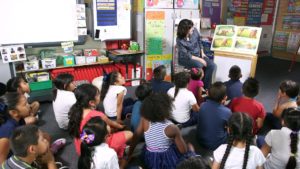This article first appeared on the Reading Recovery Council of North America website.
“Ms. Candia, Ms. Candia, did you know there’s ‘and’ in Jack and Jill? Do you hear it, Ms. Candia? Jack ‘and’ Jill—do you hear it?”
This exciting outburst from Cameron, a student in Trish Candia’s kindergarten classroom, came one day during early Spring in the midst of independent literacy time. Cameron was in the “Big Books and Charts” area, revisiting a chart of the nursery rhyme Jack and Jill, a text that had been used in multiple Shared Reading experiences throughout the school year. His teacher, meanwhile, was working with a Guided Reading group while the rest of the students were involved in various reading and writing experiences around the classroom. Cameron excitedly interrupted the Guided Reading group to share his discovery and his teacher recognized this moment of learning was important. She invited Cameron to share his learning with the entire group at the table with her. Cameron’s learning also became part of the whole-class reflections about learning that occurred at the end of the morning.
Shared Reading was a daily practice in this classroom, incorporating revisits to familiar texts and periodic introductions to new texts to begin the journey to familiarity. Some of the familiar texts used each day were selected by students, others by the teacher. Many of the texts incorporated rhyme, rhythm, and repetition; a variety of fiction, nonfiction, songs, and poetry were used across the school year. All texts provided contextualized examples of the various high frequency words being learned, opportunities to notice and name strategies being explored and applied, and a wealth of big ideas worthy of revisiting multiple times throughout the year’s reading and writing work.
For some teachers, the power of revisiting known texts may be discounted when thinking about student engagement. Engagement may be equated with entertainment, causing teachers to seek only new and unknown texts, thinking this is what holds kids’ attention and interest. Engagement for learning, however, is based on beliefs a learner holds about themselves and what’s being learned and the interactions and relationships they have with those around them in a learning setting.
Engagement for learning is more likely to occur if students see themselves as readers and writers; understand how reading and writing are important; feel they won’t be penalized for attempts and approximations; and have a caring and trusting relationship with the others in the classroom (Crouch & Cambourne, 2018) (https://www.teachingdecisions.com/teaching-decisions-that-bring-the-conditions-of-learning-to-life/.) As students revisit known texts in Shared Reading with the whole class and then again in Independent Reading, either alone or with partners, their engagement increases as they confidently begin to make sense of text at both the idea and print level. As engagement increases, so do opportunities for increasing student’s awareness of something novel within the familiar text. Each rereading of the text offers emergent and early learners opportunities to self-regulate their ever-developing understandings of print concepts, language patterns, book dialects, and “tunes of the language” (Holdaway, 1979). For Cameron, revisiting a known text served as an opportunity to notice and solidify for himself understandings about sounds and print that the class had been thinking and talking about since the beginning of the year.
Some practical ways to keep Shared Reading texts in play during the school year include:
- Begin each Shared Reading experience with an “old favorite” (https://www.youtube.com/watch?v=8VLgVCZayMo), selected by either a student or the teacher. This routinely offers students opportunities to bring new learning to a familiar text, perhaps noticing something that didn’t get attention on previous readings, or reaffirming a previously-taught skill or strategy.
- Include opportunities during Independent Reading time for students to revisit big books, charts, and songs previously used during Shared Reading. This learning experience offers increased practice in orchestrating reading behaviors, strategies, and skills.
- Dramatize a text to offer students the opportunity to internalize a story’s sequence and language. Understanding characters’ feelings and motivation is strengthened as students work to interpret a text and deliver dialogue effectively.
- Use shared reading extensions to support students to attend to details in the text. Creating an innovation on a text, where the class writes their own version of a text, supports students to notice the organizational structure of a text. Students also notice text language more closely as they work to emulate the text being recreated.
- For nonfiction texts, students may add text features that an author didn’t include, such as labels or headings or a table of contents. As students add to texts in this way, they make decisions as writers that support readers.
Revisiting texts from Shared Reading increases engagement and provides multiple opportunities for extended learning. These experiences allow students time to savor, to experiment, and to, ultimately, make the story one’s own.
Additional resources:
Crouch, D. & Cambourne, B. (2018). Teaching Decisions That Bring the Conditions of Learning to Life. http://www.teachingdecisions.com/
Holdaway, D. (1979). The Foundations of Literacy. Sydney, Australia: Ashton Scholastic.
Parkes, B. (2000). Read It Again! Revisiting Shared Reading. Portland, ME: Stenhouse Publishers.

